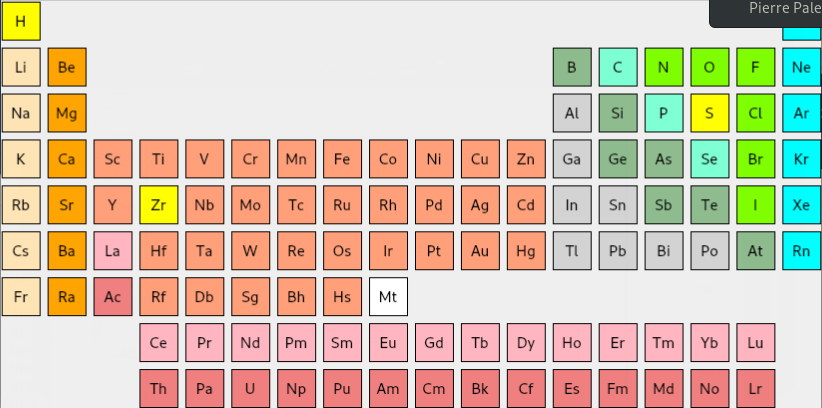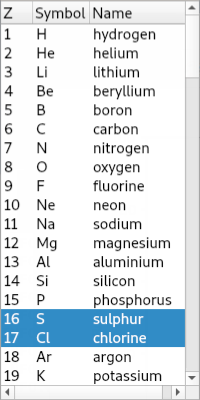PeriodicTable: Atomic elements widgets¶
Periodic table widgets
Classes¶
Widgets:
Data model:
Example of usage¶
This example uses the widgets with the standard builtin elements list.
from silx.gui import qt
from silx.gui.widgets.PeriodicTable import PeriodicTable, PeriodicCombo, PeriodicList
a = qt.QApplication([])
w = qt.QTabWidget()
ptable = PeriodicTable(w, selectable=True)
pcombo = PeriodicCombo(w)
plist = PeriodicList(w)
w.addTab(ptable, "PeriodicTable")
w.addTab(plist, "PeriodicList")
w.addTab(pcombo, "PeriodicCombo")
ptable.setSelection(['H', 'Fe', 'Si'])
plist.setSelectedElements(['H', 'Be', 'F'])
pcombo.setSelection("Li")
def change_list(items):
print("New list selection:", [item.symbol for item in items])
def change_combo(item):
print("New combo selection:", item.symbol)
def click_table(item):
print("New table click:", item.symbol)
def change_table(items):
print("New table selection:", [item.symbol for item in items])
ptable.sigElementClicked.connect(click_table)
ptable.sigSelectionChanged.connect(change_table)
plist.sigSelectionChanged.connect(change_list)
pcombo.sigSelectionChanged.connect(change_combo)
w.show()
a.exec()
The second example explains how to define custom elements.
from silx.gui import qt
from silx.gui.widgets.PeriodicTable import PeriodicTable, PeriodicCombo, PeriodicList
from silx.gui.widgets.PeriodicTable import PeriodicTableItem
# subclass PeriodicTableItem
class MyPeriodicTableItem(PeriodicTableItem):
"New item with added mass number and number of protons"
def __init__(self, symbol, Z, A, col, row, name, mass,
subcategory=""):
PeriodicTableItem.__init__(
self, symbol, Z, col, row, name, mass,
subcategory)
self.A = A
"Mass number (neutrons + protons)"
self.num_neutrons = A - Z
"Number of neutrons"
# build your list of elements
my_elements = [MyPeriodicTableItem("H", 1, 1, 1, 1, "hydrogen",
1.00800, "diatomic nonmetal"),
MyPeriodicTableItem("He", 2, 4, 18, 1, "helium",
4.0030, "noble gas"),
# etc ...
]
app = qt.QApplication([])
ptable = PeriodicTable(elements=my_elements, selectable=True)
ptable.show()
def click_table(item):
"Callback function printing the mass number of clicked element"
print("New table click, mass number:", item.A)
ptable.sigElementClicked.connect(click_table)
app.exec()
Widgets¶
- class PeriodicTable(parent=None, name='PeriodicTable', elements=None, selectable=False)[source]¶
Bases:
PyQt5.QtWidgets.QWidgetPeriodic Table widget

The following example shows how to connect clicking to selection:
from silx.gui import qt from silx.gui.widgets.PeriodicTable import PeriodicTable app = qt.QApplication([]) pt = PeriodicTable() pt.sigElementClicked.connect(pt.elementToggle) pt.show() app.exec()
To print all selected elements each time a new element is selected:
def my_slot(item): pt.elementToggle(item) selected_elements = pt.getSelection() for e in selected_elements: print(e.symbol) pt.sigElementClicked.connect(my_slot)
- sigElementClicked¶
When any element is clicked in the table, the widget emits this signal and sends a
PeriodicTableItemobject.
- sigSelectionChanged¶
When any element is selected/unselected in the table, the widget emits this signal and sends a list of
PeriodicTableItemobjects.Note
To enable selection of elements, you must set selectable=True when you instantiate the widget. Alternatively, you can also connect
sigElementClickedtoelementToggle()manually:pt = PeriodicTable() pt.sigElementClicked.connect(pt.elementToggle)
- Parameters
parent – parent QWidget
name (str) – Widget window title
elements – List of items (
PeriodicTableItemobjects) to be represented in the table. By default, take elements from a predefined list with minimal information (symbol, atomic number, name, mass).selectable (bool) – If True, multiple elements can be selected by clicking with the mouse. If False (default), selection is only possible with method
setSelection().
- getSelection()[source]¶
Return a list of selected elements, as a list of
PeriodicTableItemobjects.- Returns
Selected items
- Return type
List[PeriodicTableItem]
- setSelection(symbols)[source]¶
Set selected elements.
This causes the sigSelectionChanged signal to be emitted, even if the selection didn’t actually change.
- Parameters
symbols (List[str]) – List of symbols of elements to be selected (e.g. [“Fe”, “Hg”, “Li”])
- class PeriodicList(parent=None, detailed=True, single=False, elements=None)[source]¶
Bases:
PyQt5.QtWidgets.QTreeWidgetList of atomic elements in a
QTreeView
- Parameters
parent (QWidget) – Parent widget
detailed (bool) – True (default) display element symbol, Z and name. False display only element symbol and Z.
single – True for single element selection with mouse click, False for multiple element selection mode.
- sigSelectionChanged¶
When any element is selected/unselected in the widget, it emits this signal and sends a list of currently selected
PeriodicTableItemobjects.
- getSelection()[source]¶
Get a list of selected elements, as a list of
PeriodicTableItemobjects.- Returns
Selected elements
- Return type
List[PeriodicTableItem]
- class PeriodicCombo(parent=None, detailed=True, elements=None)[source]¶
Bases:
PyQt5.QtWidgets.QComboBoxCombo list with all atomic elements of the periodic table

- Parameters
detailed (bool) – True (default) display element symbol, Z and name. False display only element symbol and Z.
elements – List of items (
PeriodicTableItemobjects) to be represented in the table. By default, take elements from a predefined list with minimal information (symbol, atomic number, name, mass).
- sigSelectionChanged¶
Signal emitted when the selection changes. Send
PeriodicTableItemobject representing selected element
Data model¶
- class PeriodicTableItem(symbol, Z, col, row, name, mass, subcategory='')[source]¶
Periodic table item, used as generic item in
PeriodicTable,PeriodicComboandPeriodicList.This implementation stores the minimal amount of information needed by the widgets:
atomic symbol
atomic number
element name
atomic mass
column of element in periodic table
row of element in periodic table
You can subclass this class to add additional information.
- Parameters
symbol (str) – Atomic symbol (e.g. H, He, Li…)
Z (int) – Proton number
col (int) – 1-based column index of element in periodic table
row (int) – 1-based row index of element in periodic table
name (str) – PeriodicTableItem name (“hydrogen”, …)
mass (float) – Atomic mass (gram per mol)
subcategory (str) – Subcategory, based on physical properties (e.g. “alkali metal”, “noble gas”…)
- symbol¶
Atomic symbol (e.g. H, He, Li…)
- Z¶
Atomic number (Proton number)
- col¶
1-based column index of element in periodic table
- row¶
1-based row index of element in periodic table
- name¶
PeriodicTableItem name (“hydrogen”, …)
- mass¶
Atomic mass (gram per mol)
- subcategory¶
Subcategory, based on physical properties (e.g. “alkali metal”, “noble gas”…)
- class ColoredPeriodicTableItem(symbol, Z, col, row, name, mass, subcategory='', bgcolor=None)[source]¶
Bases:
silx.gui.widgets.PeriodicTable.PeriodicTableItemPeriodicTableItemwith an addedbgcolor. The background color can be passed as a parameter to the constructor. If it is not specified, it will be defined based onsubcategory.- Parameters
bgcolor (str) – Custom background color for element in periodic table, as a RGB string #RRGGBB
- COLORS = {'': '#FFFFFF', 'actinide': '#F08080', 'alkali metal': '#FFE4B5', 'alkaline earth metal': '#FFA500', 'diatomic nonmetal': '#7FFF00', 'lanthanide': '#FFB6C1', 'metalloid': '#8FBC8F', 'noble gas': '#00FFFF', 'polyatomic nonmetal': '#7FFFD4', 'post transition metal': '#D3D3D3', 'transition metal': '#FFA07A'}¶
Dictionary defining RGB colors for each subcategory.
- bgcolor¶
Background color of element in the periodic table, based on its subcategory. This should be a string of a hexadecimal RGB code, with the format #RRGGBB. If the subcategory is unknown, use white (#FFFFFF)
